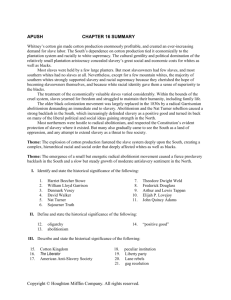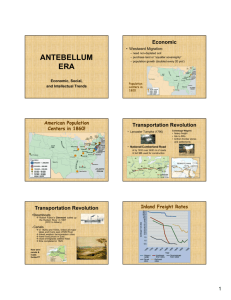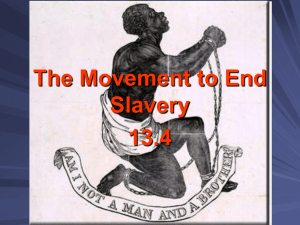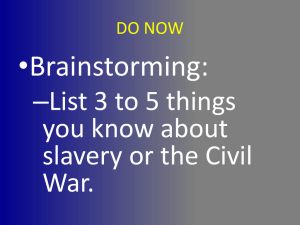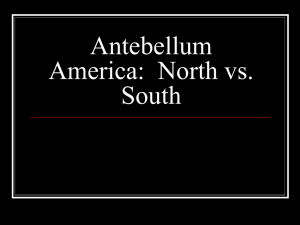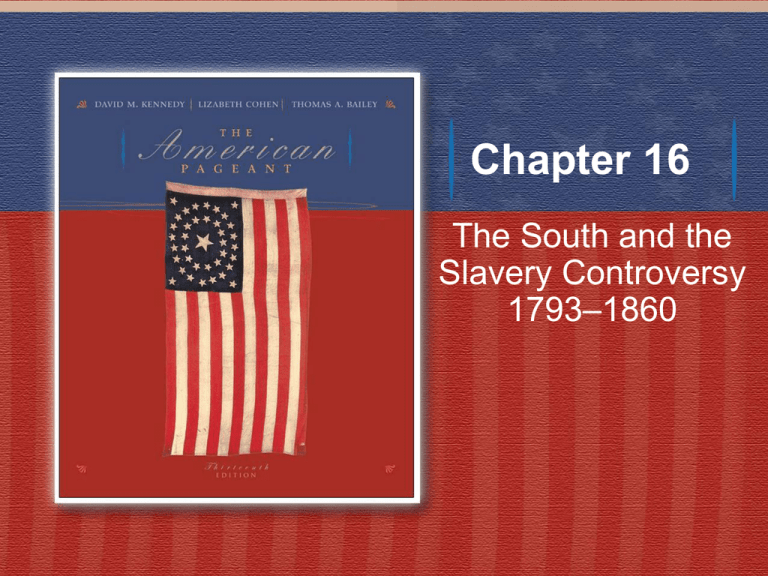
Chapter 16
The South and the
Slavery Controversy
1793–1860
The 1st Virginia Regiment
These Virginia militiamen were photographed in 1859 while attending the trial of the
abolitionist John Brown for treason against the State of Virginia. Two years later, their
regiment formed part of the Confederate army that struck for southern independence.
Cook Collection, Valentine Museum, Richmond, VA.
Cotton as King
In this Northern Civil War cartoon, the
Confederacy appears as a lighted
bomb.
Harvesting Cotton
This Currier & Ives print shows slaves of both sexes harvesting cotton, which was
then “ginned,” baled, carted to the riverbank, and taken by paddle wheeler downriver
to New Orleans.
The Granger Collection
Slaveowning Families, 1850
More than half of all slaveholding families owned fewer than four slaves. In contrast, 2
percent of slaveowners owned more than fifty slaves each. A tiny slaveholding elite
held a majority of slave property in the South. The great majority of white southerners
owned no slaves at all.
Copyright (c) Houghton Mifflin Company. All Rights Reserved.
Distribution of Slaves, 1820
The philosopher Ralph Waldo Emerson, a New Englander, declared in 1856, “I do not
see how a barbarous community and a civilized community can constitute a state. I
think we must get rid of slavery or we must get rid of freedom.”
Copyright (c) Houghton Mifflin Company. All Rights Reserved.
Distribution of Slaves, 1860
The philosopher Ralph Waldo Emerson, a New Englander, declared in 1856, “I do not
see how a barbarous community and a civilized community can constitute a state. I
think we must get rid of slavery or we must get rid of freedom.”
Copyright (c) Houghton Mifflin Company. All Rights Reserved.
A Slave Auction
Abraham Lincoln said in 1865,
“Whenever I hear anyone arguing for
slavery, I feel a strong impulse to see it
tried on him personally.”
The Granger Collection/Chicago Historical Society
Slaves Being Marched from Staunton, Virginia, to Tennessee, by Lewis
Miller, 1853
In this folk painting of slaves in transit from the upper South to the new cotton lands of
the lower South, couples travel together and children accompany parents. In reality
the forced movement of slaves often involved the painful separation of family
members.
Abby Aldrich Rockefeller Folk Art Collection, Williamsburg VA
Tags Identifying Slaves and Free Blacks in Charleston
All slaves in Charleston, South Carolina, were reminded of their status as property by
the tags they were forced to wear, marked with their skills--such as porter or
mechanic or carpenter--and the year the tag was issued. After 1848 even free blacks
had to wear tags, ensuring that no African American could be anonymous in the city.
Charleston Museum
“Am I Not a Man and a Brother?
Am I Not a Woman and a
Sister?”
A popular appeal.
Early Emancipation in the North
Although for most Northerners the Civil War was not considered to have begun over
issues of slavery, the institution had long been banned there by the 1860s.
Copyright (c) Houghton Mifflin Company. All Rights Reserved.
William Lloyd Garrison (1805–
1879)
The most conspicuous and most vilified
of the abolitionists, Garrison was a
nonresistant pacifist and a poor
organizer. He favored northern
secession from the South and
antagonized both sections with his
intemperate language.
© Bettmann/ CORBIS
Sojourner Truth
Also known simply as “Isabella,” she
held audiences spellbound with her
deep, resonant voice and the religious
passion with which she condemned the
sin of slavery. This photo was taken
about 1870.
National Portrait Gallery, Smithsonian Institution/ Art Resource, NY
A Two-Way Proslavery Cartoon
Published in New York, the cartoon shows a chilled and rejected free black in the
North (left) disconsolately passing a grogshop, while (right) a happy southern slave
enjoys life with a fishing rod in the company of a white youth.


